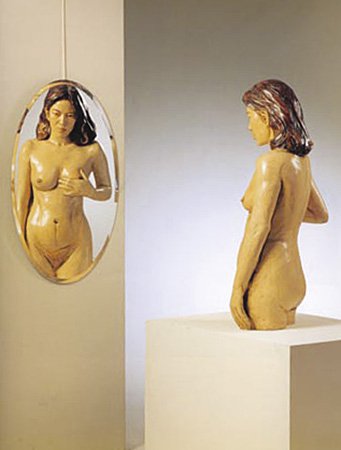Cultural Center of the Philippines
ENCYCLOPEDIA OF
PHILIPPINE ART
Thinking Nude
1988 / Terra-cotta / 94 x 44 x 38 cm / Artist: Julie Lluch / Singapore Art Museum
Executed at a time when Lluch had begun to pursue a more consciously feminist political trajectory in her practice, Thinking Nude is an image of an unclothed woman placed atop a podium—the sculpture ends at mid-thigh—and is positioned opposite an oval mirror.
The figure wears a meditative expression upon her face, with her right hand touching her right breast as if feeling something that may be out of the ordinary. Her eyes do not meet that of her reflection in the looking glass, but seem to be contemplating or appraising her body, in particular her abdomen, where scars characteristically caused by undergoing a Caesarean section can be made out.
This pensive sculpture, modeled by Teresita “Tita” de Quiros, marks a shift from the humorous, sometime self-mocking character of other major works by Lluch, such as Cutting Onions Always Makes Me Cry and Aerobics, commentaries on domestic work and exercise, respectively, which were produced in the same year as Thinking Nude.
The female nude as a category of art has been subjected to rigorous critique by various feminist thinkers for how it reinforces and perpetuates patriarchal values, turning the woman, usually idealized and arrayed in a passive, pliant pose, into an object of desire and offering it up for the enjoyment of the male spectator. In the hands of a woman artist, therefore, the nude has the potential to become even more problematic.
With Thinking Nude, Lluch negotiates the fraught history of the genre and reclaims the female body from patriarchal protocols by putting forward an alternative representation. The portrayal of an active subject who takes her body into her own hands and is absorbed in thought, intent not on being beheld by and arousing pleasure in the viewer but on self-discovery, the sculpture challenges the different discourses—artistic, medical, economic—that seek to regulate and contain the body of women.
Feminist art historian and art critic Flaudette May V. Datuin, however, has cautioned that re-functioning the nude in this way does not abolish the problem of male surveillance, as there is a vast range of interpretive possibilities for the female body, which includes the possibility that it can yet be reappropriated for voyeuristic purposes.
Written by Jaime Oscar M. Salazar
Sources
Datuin, Flaudette May. 2002a. Home Body Memory: Filipina Artists in the Visual Arts, 19th Century to the Present. Quezon City: University of the Philippines Press.
Ho, Louis. 2012. “Intersecting Histories: Contemporary Turns in Southeast Asian Art.” Art Asia Pacific, Dec. http://artasiapacific.com/Magazine/WebExclusives/IntersectingHistoriesContemporaryTurnsInSoutheastAsianArt
Literature, Culture, and Society of Singapore. 2000b. “Thinking Nude by Julie Lluch.” Jul. http://www.postcolonialweb.org/singapore/arts/sculptors/philippines/luch/1.html.
